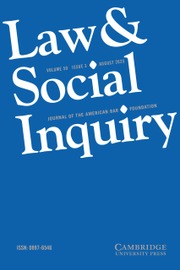No CrossRef data available.
Article contents
Deciding without Deliberating: Voices from Brazilian Jurors
Published online by Cambridge University Press: 10 October 2025
Abstract
Deliberation is routinely considered an essential component of a jury trial, contributing to the quality of fact-finding and confidence in jury verdicts. Unlike all other countries that use juries, Brazilian jurors do not deliberate. Instead, under the Brazilian jury system’s “incommunicability rule,” they submit their votes individually, without discussing the case with one another. How jurors approach the task of individual decision making and how they view and experience this notable absence of deliberation are unknown. The aim of this article, which is part of a broader research project on jurors’ decision making in femicide trials in Brazil, is to understand these experiences and views of Brazilian jurors, especially regarding the incommunicability rule. The research used qualitative methods, including ethnographic observations of trials and semi-structured interviews of jurors. The majority of jurors voiced support for the current practice, explaining that refraining from deliberation would ensure their impartiality. However, 41 percent of the jurors said that they would have liked to deliberate with others to exchange and debate views. Interviews also shed light on how the absence of deliberation affected the decision process and jurors’ satisfaction with the overall jury experience. This research contributes to an ongoing debate in Brazil over the incommunicability rule.
Information
- Type
- Articles
- Information
- Copyright
- © The Author(s), 2025. Published by Cambridge University Press on behalf of American Bar Foundation

